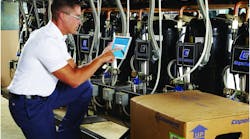The use of a digital compressor as the lead compressor in a fixed capacity refrigeration rack is becoming a preferred method for supermarkets seeking to meet varying refrigeration loads. With the ability to modulate capacity from 10 to 100 percent, a digital compressor gives operators many benefits:
• Precise matching of capacity to changing refrigeration loads
• Tight control over suction pressures
• Improved case temperature precision
• Reduced compressor cycling (on/off)
Digital compressors have proven so effective in providing capacity modulation that this strategy is being written into the design specifications of many big-box retailers.
Digital Upgrade Kit for Traditional Rack Systems
This option is also available as an upgrade to existing refrigeration systems that are based on traditional parallel rack architectures. Many technicians are being called upon to retrofit these systems with a digital compressor upgrade kit. Although there are some newer technologies and electronic controls involved with the transition, the upgrade process is relatively straightforward.
The typical scenario for a digital compressor upgrade is fairly predictable:
a) The supermarket operator has likely made several attempts to improve control of product temperature or reduce compressor cycling. It’s common in these scenarios to see cycling rates in the hundreds per day with as much as 15 F fluctuations in case temperatures.
b) Modifications to the equipment (typically via the rack controller) were unsuccessful: adjustments to narrow suction pressure resulted in excessive compressor cycling; adjustments to reduce compressor cycling produced a wide range of suction pressures and unacceptable fluctuations in temperatures.
These operating conditions present an ideal opportunity for a digital compressor upgrade:
a) Identify the compressor — the technician’s first order of business is to identify the fixed capacity, semi-hermetic or scroll compressor in the rack that is the best candidate for replacement. Ideally, the fixed compressor capacity needs to be equal to or larger than the next compressor in the stage sequence to prevent capacity gaps between compressor cycling.
b) Verify the system controller — the system controller must be capable of providing an analog signal to the digital controller. Most modern rack controllers are capable of providing analog output.
c) Choose the correct upgrade model — once the replacement compressor has been identified, Emerson Climate Technologies offers an upgrade kit per specific model (Copeland Discus Digital™ or Copeland Scroll™). Note: for semi-hermetic compressors that are less than four years old, technicians can perform a head modification to convert the compressor to digital.
d) Select the digital controller — the new digital compressor necessitates an additional interface controller to tie into the rack system’s master controller.
e) Install upgrade kit — often the greatest apprehension about the upgrade process is the wiring required to tie into the interface controller, even though the process is fairly straightforward. The length of time required to install depends on the technician’s experience and electrical familiarity.
Digital Technology Yields Indisputable Results
A single digital compressor with 10 to 100 percent capacity modulation enables continuous variable unloading that delivers immediate and significant benefits. While results vary per application, operators can expect improvements in three major categories:
• Reduced compressor cycling — the average compressor cycling is reduced up to 50 percent, but some scenarios have seen cycle counts go from 900 starts per day to 12 starts across a four-day span. This increases equipment reliability by reducing contactor wear and tear due to the infrequent cycling. It also saves energy from reduced in-rush, start-up currents and persistent consumption from running at full capacity.
• Improved temperature control — digital modulation is capable of temperature control within +/- 1 °F, giving operators the assurance that they are minimizing food loss while maintaining the highest quality of perishable items.
• Tighter suction pressure control — operating suction pressure ranges are significantly reduced, moving from double-digit suction pressures (psig) to single-digit levels. In some systems, operators have experienced as much as 89 percent improvement in suction pressure.
These results make an open and shut case for a digital compressor upgrade. As awareness of this option becomes more well-known, many supermarket operators will opt for capacity modulation using this relatively simple upgrade to their existing rack systems.









